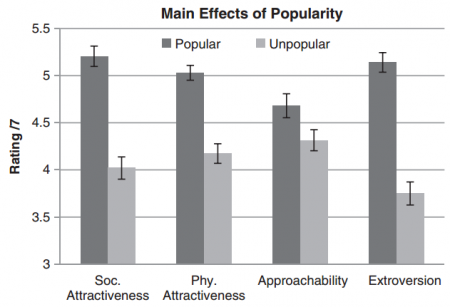When You Are Popular on Facebook, Strangers Think You’re Attractive
![]() From psychology, we’ve known for a while that people create near-instant impressions of people based upon all sorts of cues. Visual cues (like unkempt hair or clothing), auditory cues (like a high- or low-pitched voice), and even olfactory cues (what’s that smell!?!) all combine rapidly to create our initial impressions of a person. Where things get interesting is when one set of these cues is eliminated. For example, if we’ve never met a person in a real life, do we form impressions of people when all we know about them is their Facebook profile? And if so, what do we learn from those profiles?
From psychology, we’ve known for a while that people create near-instant impressions of people based upon all sorts of cues. Visual cues (like unkempt hair or clothing), auditory cues (like a high- or low-pitched voice), and even olfactory cues (what’s that smell!?!) all combine rapidly to create our initial impressions of a person. Where things get interesting is when one set of these cues is eliminated. For example, if we’ve never met a person in a real life, do we form impressions of people when all we know about them is their Facebook profile? And if so, what do we learn from those profiles?
As it turns out, it can be quite a lot. In an upcoming issue of the Journal of Computer-Mediated Communication, Scott1 experimentally examined the impact of viewer gender, Facebook profile gender and number of Facebook friends on impression formation, finding that people with lots of friends appear more socially attractive, more physically attractive, more approachable, and more extroverted.
To determine this, the researcher first conducted a pilot study of 600 existing Facebook profiles (although the source of these profiles is not revealed). From that study, it appears that the researcher extracted wall posts at random to create new profiles, replacing the photo with one drawn from a database of photographs with known attractiveness to a photo of moderate attractiveness (all four within 0.05 SD of each other), updating the number of friends to match the needed condition (90-99 for unpopular and 330-340 for popular), and updating the number of photos to match the needed condition (60-80 for unpopular and 200-250 for popular). This created a database of essentially random Facebook content, although the reason for these particular numbers (or their ranges) was never given.
In the main study, each of 102 undergraduate research participants saw all 4 conditions, in a random order. All participants viewed the profiles on the same computers in the same research laboratory and completed a survey afterwards.
In analyses, neither research participant gender nor profile gender affected any of the five outcomes: social attractiveness, physical attractiveness, approachability, extroversion, and trustworthiness. The only effects found were those from the experimentally controlled popularity manipulation, and these effects were noteworthy.
This figure is a little misleading, since the y-axis doesn’t go down to the bottom of the scale (which was 1), but the effects are still fairly substantial: standard deviations were around 1.2, so these effects range from roughly 0.3 to 1.0 standard deviation – which are moderate to large in magnitude. It is also a little misleading that the trustworthiness outcome is not within the graph, which was assessed but was not statistically significant.
Despite these very small limitations, this study quite cleanly demonstrates that people form a halo of impressions from relatively small cues, just as they do in “real life.” Manipulating only the number of friends and number of posted photos led research participants to view the people behind the profiles as more physically attractive, among other outcomes. This is a critical finding for research examining the value of Facebook profiles and other social media for real-life processes, like hiring or background checks – even relatively small cues can dramatically influence seemingly unrelated judgments made about a person, for better or worse.
- Scott, G. G. (2014). More than friends: Popularity on Facebook and its role in impression formation Journal of Computer-Mediated Communication DOI: 10.1111/jcc4.12067 [↩]
| Previous Post: | Do Recommendation Letters Actually Tell Us Anything Useful? |
| Next Post: | Unpacking the Top 10 I/O Psychology Trends for 2014 |

Trackbacks and Pingbacks